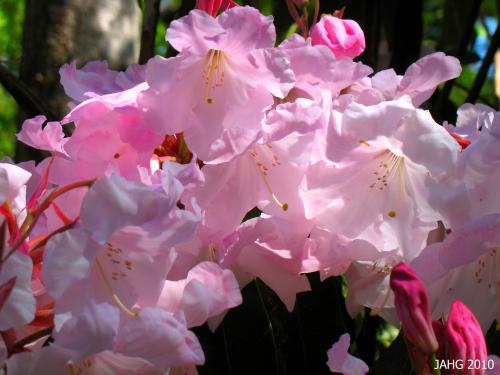When I was working at Park & Tilford Gardens during my practicum I worked rotations in all parts of the gardens there. Each section had different challenges and things to learn. Everyday we would have to start with the rotine things like skimming the pool for leaves or deadheading the roses, one day as I cleaned in the display garden I smelled the most wonderful perfume coming from a plant. Being curious I had to find out where the scent was coming from and to my surprise it came from a huge white rhododendron. I asked about this plant and found out it was one of the famous Loderi Rhododendrons‘, ‘Loders White’which I have not seen since that time. Here in Victoria I have discovered several more all with the same delicious scent.
‘Loderi’ Rhododendron where developed by Sir Edmund Loder (1849-1920) who bought Leonardslee Estate(St. Leonard’s forest) in 1889 from his wifes family. Sir Edmund then started to plant the estate with a collection of plants which included everything from vegetables and fruit for household use as well as trees and shrubs. It is here that he did his crossing of two well known species of Rhododendron to produce what we know as Loder Rhododendrons.
‘Loderi’ Rhododendrons were developed by crossing the pollen(male)of species griffithianum with fortunei (female). The species ‘griffithianum which is very tender contributed the extremely large flowers and often the beautiful bark, and the ‘fortunei’ added its scent, hardiness and more vigorous growth. Both of these species had already been used a great deal for hybridizing as they were some of the first to be brought to Europe.

The species 'fortunei' contributed color, fragrance, vigor and cold hardiness to Loderi Rhododendrons.
From the original crosses made in 1901 a number of selections of ‘Loderi’ Rhododendrons were made and named. All of the plants are extremely large growing and obtain tree-like size. Colors range from pure white through creamy shades into a mid pink. All have been award numerous medals in the garden world including Awards of Merit(AM), First Class Certificates(FCC) and Awards of Garden Merit(AGM) which all come from the Royal Horticultal Society(RHS). Here in Victoria there are several places to view these plant with the best being Finnerty Gardens. Also look in the Novitiate Garden at St. Ann’s Academy and Glendale Gardens for other forms.
‘Loderi’ Rhododendrons are big plants with some attaining over 10m(30ft) with time, they are also as wide. You will need a large space which is not near a building for them to grow their best. Here they can be grown in almost full sun with no damage seen, in other areas where light is stronger a woodland setting would be more appropriate. Rhododendrons likes acidic soils which are slightly damp as they have shallow roots. Mulching every year is also a good idea. Loderi Rhododendrons are rated as tolerating -15c(5f) at the extreme. Propagation is by cuttings which are slow to produce.

Every year People come to Finnerty Garden to photograph the beautiful 'Miss Josephine Firth', a massive Loderi Rhododendron.
Notes to Look at:
History of Leonardsee and Loders’ Nursery:http://www.leonardsleenursery.com/history
Rhododendron fortunei:http://www.rosebay.org/chapterweb/specfort.htm
Rhododendron griffithianum: http://www.rhododendron.org/descriptionS_taxon.asp?ID=17
Until we meet again along the garden path….























 Stumble It!
Stumble It!






